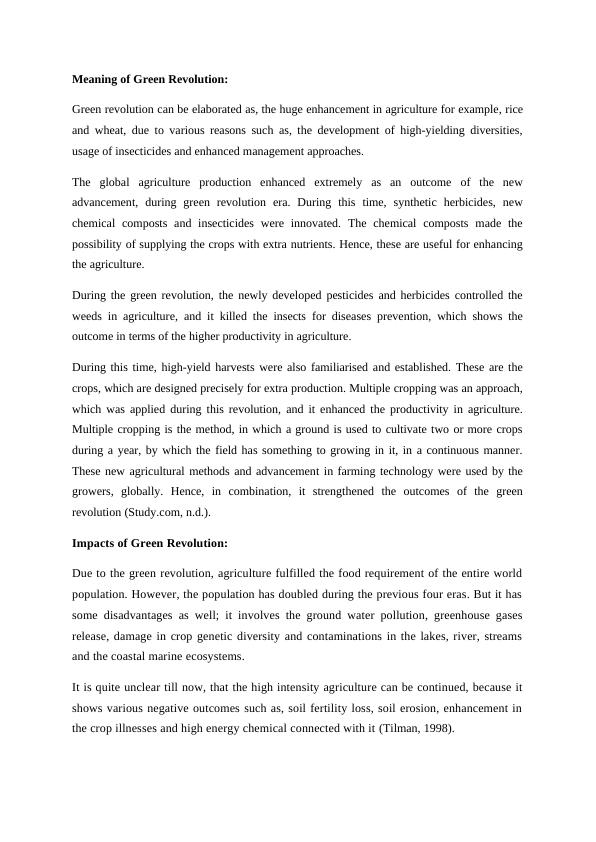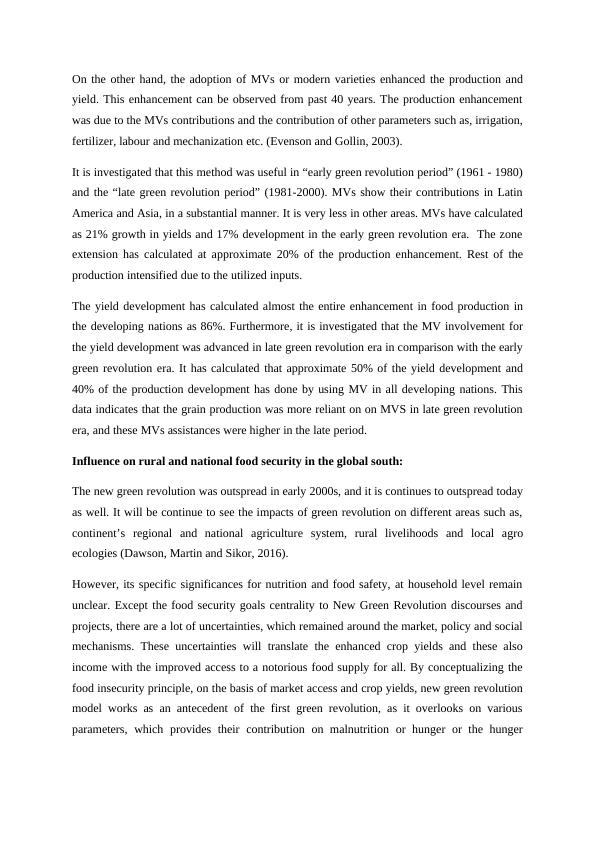Green Revolution Report 2022
Added on 2022-09-16
9 Pages2044 Words20 Views
Green Revolution

Meaning of Green Revolution:
Green revolution can be elaborated as, the huge enhancement in agriculture for example, rice
and wheat, due to various reasons such as, the development of high-yielding diversities,
usage of insecticides and enhanced management approaches.
The global agriculture production enhanced extremely as an outcome of the new
advancement, during green revolution era. During this time, synthetic herbicides, new
chemical composts and insecticides were innovated. The chemical composts made the
possibility of supplying the crops with extra nutrients. Hence, these are useful for enhancing
the agriculture.
During the green revolution, the newly developed pesticides and herbicides controlled the
weeds in agriculture, and it killed the insects for diseases prevention, which shows the
outcome in terms of the higher productivity in agriculture.
During this time, high-yield harvests were also familiarised and established. These are the
crops, which are designed precisely for extra production. Multiple cropping was an approach,
which was applied during this revolution, and it enhanced the productivity in agriculture.
Multiple cropping is the method, in which a ground is used to cultivate two or more crops
during a year, by which the field has something to growing in it, in a continuous manner.
These new agricultural methods and advancement in farming technology were used by the
growers, globally. Hence, in combination, it strengthened the outcomes of the green
revolution (Study.com, n.d.).
Impacts of Green Revolution:
Due to the green revolution, agriculture fulfilled the food requirement of the entire world
population. However, the population has doubled during the previous four eras. But it has
some disadvantages as well; it involves the ground water pollution, greenhouse gases
release, damage in crop genetic diversity and contaminations in the lakes, river, streams
and the coastal marine ecosystems.
It is quite unclear till now, that the high intensity agriculture can be continued, because it
shows various negative outcomes such as, soil fertility loss, soil erosion, enhancement in
the crop illnesses and high energy chemical connected with it (Tilman, 1998).
Green revolution can be elaborated as, the huge enhancement in agriculture for example, rice
and wheat, due to various reasons such as, the development of high-yielding diversities,
usage of insecticides and enhanced management approaches.
The global agriculture production enhanced extremely as an outcome of the new
advancement, during green revolution era. During this time, synthetic herbicides, new
chemical composts and insecticides were innovated. The chemical composts made the
possibility of supplying the crops with extra nutrients. Hence, these are useful for enhancing
the agriculture.
During the green revolution, the newly developed pesticides and herbicides controlled the
weeds in agriculture, and it killed the insects for diseases prevention, which shows the
outcome in terms of the higher productivity in agriculture.
During this time, high-yield harvests were also familiarised and established. These are the
crops, which are designed precisely for extra production. Multiple cropping was an approach,
which was applied during this revolution, and it enhanced the productivity in agriculture.
Multiple cropping is the method, in which a ground is used to cultivate two or more crops
during a year, by which the field has something to growing in it, in a continuous manner.
These new agricultural methods and advancement in farming technology were used by the
growers, globally. Hence, in combination, it strengthened the outcomes of the green
revolution (Study.com, n.d.).
Impacts of Green Revolution:
Due to the green revolution, agriculture fulfilled the food requirement of the entire world
population. However, the population has doubled during the previous four eras. But it has
some disadvantages as well; it involves the ground water pollution, greenhouse gases
release, damage in crop genetic diversity and contaminations in the lakes, river, streams
and the coastal marine ecosystems.
It is quite unclear till now, that the high intensity agriculture can be continued, because it
shows various negative outcomes such as, soil fertility loss, soil erosion, enhancement in
the crop illnesses and high energy chemical connected with it (Tilman, 1998).

On the other hand, the adoption of MVs or modern varieties enhanced the production and
yield. This enhancement can be observed from past 40 years. The production enhancement
was due to the MVs contributions and the contribution of other parameters such as, irrigation,
fertilizer, labour and mechanization etc. (Evenson and Gollin, 2003).
It is investigated that this method was useful in “early green revolution period” (1961 - 1980)
and the “late green revolution period” (1981-2000). MVs show their contributions in Latin
America and Asia, in a substantial manner. It is very less in other areas. MVs have calculated
as 21% growth in yields and 17% development in the early green revolution era. The zone
extension has calculated at approximate 20% of the production enhancement. Rest of the
production intensified due to the utilized inputs.
The yield development has calculated almost the entire enhancement in food production in
the developing nations as 86%. Furthermore, it is investigated that the MV involvement for
the yield development was advanced in late green revolution era in comparison with the early
green revolution era. It has calculated that approximate 50% of the yield development and
40% of the production development has done by using MV in all developing nations. This
data indicates that the grain production was more reliant on on MVS in late green revolution
era, and these MVs assistances were higher in the late period.
Influence on rural and national food security in the global south:
The new green revolution was outspread in early 2000s, and it is continues to outspread today
as well. It will be continue to see the impacts of green revolution on different areas such as,
continent’s regional and national agriculture system, rural livelihoods and local agro
ecologies (Dawson, Martin and Sikor, 2016).
However, its specific significances for nutrition and food safety, at household level remain
unclear. Except the food security goals centrality to New Green Revolution discourses and
projects, there are a lot of uncertainties, which remained around the market, policy and social
mechanisms. These uncertainties will translate the enhanced crop yields and these also
income with the improved access to a notorious food supply for all. By conceptualizing the
food insecurity principle, on the basis of market access and crop yields, new green revolution
model works as an antecedent of the first green revolution, as it overlooks on various
parameters, which provides their contribution on malnutrition or hunger or the hunger
yield. This enhancement can be observed from past 40 years. The production enhancement
was due to the MVs contributions and the contribution of other parameters such as, irrigation,
fertilizer, labour and mechanization etc. (Evenson and Gollin, 2003).
It is investigated that this method was useful in “early green revolution period” (1961 - 1980)
and the “late green revolution period” (1981-2000). MVs show their contributions in Latin
America and Asia, in a substantial manner. It is very less in other areas. MVs have calculated
as 21% growth in yields and 17% development in the early green revolution era. The zone
extension has calculated at approximate 20% of the production enhancement. Rest of the
production intensified due to the utilized inputs.
The yield development has calculated almost the entire enhancement in food production in
the developing nations as 86%. Furthermore, it is investigated that the MV involvement for
the yield development was advanced in late green revolution era in comparison with the early
green revolution era. It has calculated that approximate 50% of the yield development and
40% of the production development has done by using MV in all developing nations. This
data indicates that the grain production was more reliant on on MVS in late green revolution
era, and these MVs assistances were higher in the late period.
Influence on rural and national food security in the global south:
The new green revolution was outspread in early 2000s, and it is continues to outspread today
as well. It will be continue to see the impacts of green revolution on different areas such as,
continent’s regional and national agriculture system, rural livelihoods and local agro
ecologies (Dawson, Martin and Sikor, 2016).
However, its specific significances for nutrition and food safety, at household level remain
unclear. Except the food security goals centrality to New Green Revolution discourses and
projects, there are a lot of uncertainties, which remained around the market, policy and social
mechanisms. These uncertainties will translate the enhanced crop yields and these also
income with the improved access to a notorious food supply for all. By conceptualizing the
food insecurity principle, on the basis of market access and crop yields, new green revolution
model works as an antecedent of the first green revolution, as it overlooks on various
parameters, which provides their contribution on malnutrition or hunger or the hunger

End of preview
Want to access all the pages? Upload your documents or become a member.
Related Documents
Companies in Canadian Agrochemical Marketlg...
|7
|1244
|86
Human Geography Question Answer 2022lg...
|18
|3395
|39
Advanced Soil Mechanics: Task Blg...
|2
|552
|28
Identifying Organic Food Practices in the Agricultural Sector in China: A Consumer Perspectivelg...
|24
|6860
|89